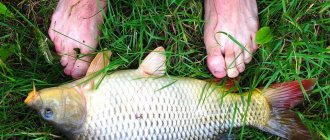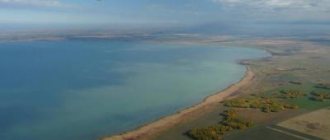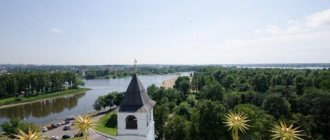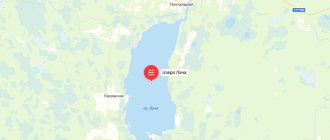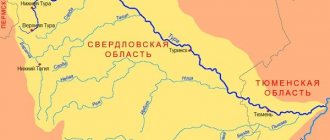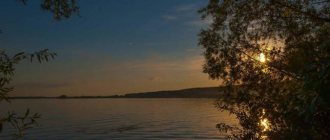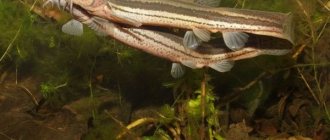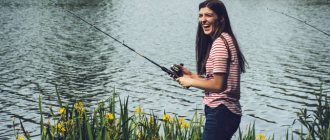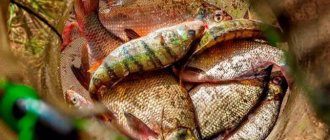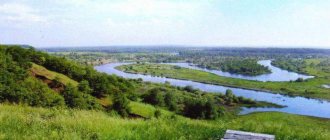Fishing on the Inya River in the Altai Territory
In the Altai Territory there are many reservoirs with their regulars, I mean fish - crucian carp, perch, roach, pike, etc. These fish, as a rule, are what fishermen need to “take their soul away”.
But the heart still requires something more, for example, to catch a noble fish - grayling. For which you have to go to the mountains, sometimes for most fishermen such a road to fishing spots is not a short distance and costs a pretty penny. We will talk about one such place; it is located in the Krasnoshchekovsky district of the Altai Territory, near the village of Chineta. And finally, about the reservoir itself, this is a fish river in the literal sense of the word - the Inya . You can see this area in more detail on the map.
The three of us went fishing after work on Friday, September 16, in our dear VAZ “nine” for two days. Our route from Barnaul along which we went to the place of grayling fishing on the Inya River passed through the city of Aleysk - the village. Krasnoshchekovo, village Karlovo, s. Maralikha, then through the pass, a suspension bridge over the Charysh River and before reaching about 4 km to the village. Chineta, we arrived at the Inya River already after dark. Upon arrival, after dinner, we went to bed in our previously deployed tents and sleeping bags. Keep in mind that nights are always colder in mountainous areas. The name of the river is not unique and there are several rivers in Russia in different regions with this name. Our Altai River Inya is a tributary of the Charysh River.
The Inya River of the Altai Territory cut its path through the mountains and now flows among the Altai mountain range. What such rivers are rich in is, of course, grayling and taimen. The thing is that these noble fish love clean and cold water. The current is stormy and fast, the river is not deep and not wide, but few people dare to cross to the other side. The current sweeps you off your feet. To get to the opposite side you need to have a boat with you.
Inya River
The Inya River originates from the southern slopes of the Taradanovsky ridge and winds for almost 533 km through the densely populated forest-steppes of the Belovsky, Leninsk-Kuznetsky and Promyshlenny districts, and goes to the Novosibirsk region. The Inya is a typical lowland river; it has a well-developed valley with many oxbow lakes and floodplain lakes, and flows into the Ob River. In total, 32,109 rivers flow through the territory of Kuzbass with a total length of 245,152 km. All rivers belong to the Ob River basin, which ranks first in Russia in terms of drainage area. Six rivers of Kuzbass flow through the territory of two or more constituent entities of the Russian Federation - Tom, Inya, Kiya, Yaya, Chulym, Chumysh. Four main water basins are formed on the territory of the region: the river. Tom, b. Inya, b. Chulym, b. Chumysh, which are rivers of federal significance. Due to the characteristics of the relief, climate, and geological conditions, the river network is not evenly developed and is divided into rivers of the plain and mountain types. The Tom and Inya rivers are the main surface sources of water supply in the Kemerovo region.
Inya River. The right tributary of the Ob, the Inya River, originating from the southern slope of the Taradanovsky ridge, is a typical lowland river of the Kuznetsk steppe and forest-steppe. Its length is 663 km. It has a well-developed valley with many oxbow lakes, floodplain lakes and meanders. Several rivers flowing from the Salair Ridge flow into the Inya: Bolshoy and Maly Bachata, Ur, Kasma, Izyla, etc. Near the village of Inskoye, not far from the city of Belovo, a dam was built on the Inya River, which made it possible to create a reservoir here - the so-called Belovskoe Sea — and a recreation area on its shore. The reservoir is an excellent water reservoir for breeding valuable fish species. The right bank of the Inya is steeper and higher than the left bank for a considerable distance; terraces are observed along the banks of the river.
In spring, the Inya and its tributaries overflow heavily, reaching a width of 3 km or more. Rounding the Taradanovsky ridge on the western side, Inya makes several meanders and takes a northwestern direction. The northern spurs of the Salair Ridge turn it to the west, and it goes to the Novosibirsk region, where it flows into the Ob River near Novosibirsk. Inya originates from the southern slopes of the Taradanovsky ridge and winds for almost the entire 533 km through the densely populated forest-steppe of parts of the Belovsky, Leninsk-Kuznetsky and Promyshlennovsky districts, and, having gained strength, goes to the Novosibirsk region. There she is received by the mighty Ob. The river wakes up from its winter slumber early, in mid-April, and freezes in early November.
Fishermen love to be on the shores; Inya gave many happy moments of great fishing success. And now perches are robbing its holes, pikes are basking in the coastal sedge, hiding, and burbot are gaining fat in coastal burrows and under stones. It’s not for nothing that the village of Lebedi stands on its shore, which means that these fabulous birds were here too, there were forests, and it’s not for nothing that it’s called Berezovo, Ust-Sosnovo. On its way, Inya collects the waters of many small rivers flowing from the Salair ridge and its foothills: Ur, Kasma, Tarsma, Izyly. Ur is narrow in its banks, but deep. These and many nameless rivers “supply” Inya with fish, and ducks nest in the willow thickets and adjacent swamps.
Grayling fishing on the Ina
Grayling bites on the Ina in summer and autumn until freeze-up. In November, when the ice edge appears along the banks, there are more grayling the river And only in November grayling weighing a kilogram or more is caught It is caught by fly fishing at the top of the water, and with spinning rods (fishing rods) with a Tyrolean stick and with a tackle with flies, which local fishermen for some reason call “ bulda ”. You should not compare this tackle with the tackle of the same name for perch fishing.
Our fishing began at dawn on Saturday morning. The weather was great and blessed us with sunshine for two days. There was no fly fishing gear in our arsenals. We fished with spinning rods with Tyrolean sticks and white and yellow flies, with periodic changes to spinning rods with a loaded “buldo”, on which the same flies .
Tackle for fishing grayling on the Inya River
A little about gear. Spinning rods for grayling fishing should be ultra light or light. The main fishing line on spinning rods is ∅ 0.16 mm braid, on leashes with flies the usual (Japanese) fishing line is ∅ 0.22 mm, inexpensive flies in different colors. When there are flies of different colors on the bulldozer, it is easier to understand what color flies are preferable to grayling.
It happens that in the course of one day, first he takes one bait, then another. Or, on the contrary, he actively grabs the same flies. For us, the best working baits for grayling were white and yellow flies. Within an hour after dawn, at least a dozen fish were flopping around in the cages.
Balda for grayling on the Inya River
The “balda” float is made of dense foam or wood.
At the very bottom of the float, a weight equal to half the weight of the float is attached to add weight. For a float, the load is very important, otherwise there will be no proper line tension and sensitivity to the grayling bite. A hole is drilled in the central part of the float with a slope for the passage of the fishing line. The fishing line is passed through the float into an inclined hole and tied to a ring. The ring is a screw with a ring. The number of leashes with flies varies from 2 to 4 pieces and depends on the length of the spinning rod; the longer it is, the more leashes you can install. A short spinning rod is not convenient for casting tackle with more than 2 leads.
The length of the leashes is 10 - 15 cm. They are placed at intervals of 20 - 50 cm from the float. Triple swivels are used to attach leashes to the main fishing line. But there is another way. Two beads for stopping (2) are attached to the main line of the “bald” (1). A small button with two holes (3) is placed in the middle; the main fishing line is passed through one of them, and the other is used to attach the leash (4). The leashes are equipped with flies or real insects. This gear is exactly what you need for catching grayling on fast rivers, which includes the Inya .
You need to throw the tackle upstream. Periodically twitch the line and constantly monitor the float. The distance of descent downstream is 100-150 m. After that, the tackle is pulled towards you and thrown back again.
How does the grayling bite on the “balda” happen?
When a grayling bites on a “balda,” it feels like it occurs with a sharp blow and a pull. With a good bite, it is not uncommon to be caught on each leash at the same time.
Tackle for grayling with a Tyrolean stick on the Inya River
The tackle with a Tyrolean stick is simple; you can make it on your knees in 10 minutes with all the components. The diagram shows what the tackle consists of, as well as all the necessary dimensions and distances.
Tackle with a Tyrolean stick, unlike the “balda”, catches in the lower layers of the river, and the Tyrolean stick itself rolls along the rocky bottom without snags.
What gear is used to catch grayling?
The rod should be light or ultra-light, fishing line 0.22 mm thick, multi-colored inexpensive flies.
To understand which color of bait the fish prefers, several of them are attached to the beam. Grayling is capricious in its choice.
Over a short period of time, he can repeatedly change his preferences regarding baits or choose the same ones.
Since the Inya is a fast river, the leashes are equipped with real insects. This is the most optimal gear option for this type of current.
Fishermen often use a tackle called a Tyrolean stick. It is very easy to make.
If a boom, a foam or wooden float with an attached load, has proven itself well in the upper layers of water, then the Tyrolean stick is lowered almost to the bottom.
These two devices showed themselves well when fishing for grayling. According to some fishermen, in 2 days of quiet hunting they caught up to 25 kilograms of this type of fish on the Ina.
The Inya River is a relatively small tributary of the Ob.
It flows in two Russian regions: Novosibirsk and Kemerovo. Few people know or have heard about it, with the exception of fishermen, since it is one of the small number of reservoirs where you can catch a lot of fish without much difficulty.
Fishing in the Altai Territory
Getting to this region is quite easy; trains even run to Barnaul from Moscow. There is an interesting train from Abakan, it has a cheap general compartment carriage, low fares, and all passengers can travel lying down at night. You can fish in the Altai Territory on rivers, lakes and reservoirs.
Fishing on Sorochi Log
Near the village of Sorochiy Log there is a reservoir of the same name. In the village itself you can visit the spring and the monastery monastery. Fishing on the reservoir will be interesting for both fans of spinning fishing and those who use carp tackle or a float rod.
The reservoir is also home to local fish species, the so-called “natives” - roach, bream, ruffe, perch, as well as introduced silver carp and pike perch. A visit to the reservoir costs 200 rubles for a fisherman, and a wife and child are allowed in for free. You need to pay 200 rubles for entry by car and 300-500 for entry by minibus. The drive to Barnaul is 45 kilometers.
Not every angler will like Sorochy Log. The fact is that the fish there are capricious; for fishing it is advisable to have experience and theoretical knowledge. But there is a reason to try new equipment and fishing tactics. Some fishermen write in their reviews of fishing in May in the morning that “the roach bites like a machine gun.”
The depth of the reservoir is 8 meters. Fishing competitions are held on its banks for employees of various enterprises in the region.
In the spring, fishermen noticed ticks in this area.
It is allowed to use boats with an electric motor. On the banks of the reservoir there are benches, tables, toilets and trash cans.
fishing boat
Tourist base "Razdolye 22"
In the Shelabolikha district of the Altai Territory you can go fishing all year round at the Razdolye 22 camp site. It has the necessary infrastructure, for example, houses for living 150 meters from the Ob River. A place in the house costs 300 rubles per person, and the entire place can be rented for 1,000 rubles per day. The lighting in them is diode, battery powered. If you pay for your stay in the house, parking will be free, but its price is 70 rubles. The houses are equipped with a wood-burning stove, barbecue and smokehouse.
In winter, at the camp site you can rent an ATV and a snowmobile in winter (rent from 50 rubles per day). There is a toilet and 24-hour security. Bathhouse reservation – 500 rubles per hour. Within the base, fishermen can be transported by snowmobile to their winter fishing spot for 500 rubles.
Fishing is allowed all year round and around the clock, but nets are prohibited. You can catch all the fish that live in the Ob, for example, large pike.
Panorama of the river in Altai
Pravdinskoye Reservoir
A reservoir with an area of 40 hectares east of Barnaul and Novoaltaisk. You can relax and fish on it free of charge. Boats are allowed, including those with motors.
In the Pravdinsky Reservoir they catch bream, carp, perch, pike, pike perch, carp, tench, crucian carp, roach, trout, peled and crayfish.
There are water attractions on the territory of the reservoir, and there are rental points for various equipment for tourists. In winter it is popular with fishermen, some of whom believe that fishing is better at this time of year.
The area around the reservoir is inhabited by otters, sheep, foxes and larks. Among the plants near it grow adonis, ginseng, and sea buckthorn.
You can stay at camp sites (Eden, Mountain Fairy Tale and Altair) and in a tent camp on the shore.
Beshentsevo Reservoir
It is located near the village of the same name not far from Zarinsk, 51 kilometers from the regional center. The cost of fishing is 110 rubles per day; there is a seasonal ticket for people over 70 years old. Fishing is allowed with hook and line gear. The reservoir is home to crucian carp, roach, carp, perch, pike and grass carp, that is, fish typical for this region.
One of the cleanest bodies of water within a radius of 100 kilometers from Barnaul. The banks are regularly cleaned of debris. On its right bank there is a recreation center with 7 houses, as well as a barbecue area, places for tents and gazebos for gatherings. You can rent jet skis and catamarans.
Entry into the territory costs 200 rubles. There is no limit to the number of fish you can catch. Competitions for the best fisherman may be held in July-August.
On the downside, it should be noted that sometimes visitors come across ticks.
Charysh River
It is distinguished by a large number of rapids, rifts and tributaries. The depth ranges from 2.5 meters in the upper reaches and up to 5 meters in the lower reaches. There are caves along the coastline. Overall, it is a beautiful place; its waters are home to pike perch, perch, taimen, burbot, grayling, bream and pike.
The best fishing is near the villages of Sentelek and Charyshskoye. They can be reached not only by car, but also by public transport. Fishing is allowed with spinning rods, float rods and bottom gear.
According to fishermen, bream weighing 0.5-1 kg bite, and bite especially well in the mornings and at dusk. During the day you may encounter crucian carp, sorog and ruff.
Some fishermen use motor boats and catch pike, sometimes up to 40 pike per day.
Among the problems in this reservoir are mosquitoes, gadflies and midges. Sometimes they eat fishermen, so you should use spirals, they need to be set on fire in a circle, up to 10 pieces.
Landscapes of Altai
Horsetail Lake
It is located southwest of Biysk, near the Ust-Charyshskaya pier and the settlement of Nizhneozernoye. You need to drive to it along a field road; this should be taken into account when planning your fishing trip.
Fish are caught using winter and summer lures and a float rod. Perch, pike, crucian carp and chebak are well caught.
Lake Eraska
It is located south of Barnaul, on the A-322 highway near the Ob River and the river of the same name near the village of Buranovo. Drive 42 kilometers along the Zmeinogorsk highway. It is especially good for winter fishing for crucian carp, but sometimes you can also catch pike. To catch, you can use a fishing rod with a nod.
According to fishermen, the bite is average.
Pond Aviator
This reservoir is located closest to Barnaul and is good for fishing in both winter and summer. Fishing is paid, and payment is taken not only for the stay, but also for the catch. Payment goes towards stocking the reservoir with fish and improving it. The fee for a fisherman or family is 600 rubles. The standard catch is 1 kilogram, and excess must be paid separately at a price of 200 rubles or released back into the reservoir. Fishermen are allowed to use fishing rods, feeders, donks and spinning rods. Just entering the pond costs 250 rubles per person. Children under 14 years old are admitted free of charge.
Fishing in the Altai Republic
This is a rare region of Russia where there are no railways. It is best to get to it by your own car or by bus from Barnaul and Biysk. Lots of fishing spots, beautiful nature and low population density.
Lake Teletskoye
A unique lake with a depth of 330 meters, one of the 25 deepest in the world. You need to get to it from Biysk through the regional center Turochak. It is best to stay on the northern shore at the tourist centers of Artybash and Yogach. The most convenient way to get to the fishing spot is on rented boats and motorboats, however, sometimes people fish on the shore.
Various rivers flow into Lake Teletskoye, their mouths are also suitable for fishing, for example, Yeshtora, Chili, Samysh.
The lake is home to 18 species of fish. Among them, for example, are the following:
- Grayling, up to 800 grams in weight.
- Teletsky whitefish, from 300 grams to 1 kilo in weight. Endemic, not found in other lakes.
- The large fish is the Uskuch, its weight can reach 5 kilos.
- Pike, its weight can reach 10 kilos.
- Burbot, up to 5 kilos in weight.
- Taimen. The largest fish in Lake Teletskoye weighs 40-60 kilos. Its length reaches two meters.
When planning a fishing trip to Lake Teletskoye, you should take into account that the weather there is changeable, you need to be prepared for wind, rain, and cold temperatures.
You also need to know that only the left bank of the lake is used for fishing, and its right part is a nature reserve where fishing is prohibited. But on the right bank you can visit the beautiful Korbu waterfall.
Fishing on Lake Teletskoye is prohibited during the spawning period, but the period may differ for different fish, so you may be able to catch someone. You can fish all year round. In winter, fishing occurs from the ice. This prevents a good catch of pike, perch and other fish species.
For fishing they use spinning rods, fishing rods and ordinary fishing rods.
The large and rare taimen fish should be caught in June and September in the tributaries of Lake Teletskoye. It is listed in the Red Book of Altai, so after catching it must be released. The same rule applies to whitefish Pravdin, but it is not necessary to release grayling; its local residents know how to cook deliciously.
Shavlinskie lakes
The height of these lakes above sea level is about 2200 meters. The width of the largest of them is 500 meters, and the length is 1.5 kilometers. The climb from the lower lake to the upper one takes a whole day. The best place to fish is on the Shavla River. Grayling is the best fish to catch. Fishing gear can be obtained during a walk or horseback riding trip for an organized group, which takes 7 days.
Fish catch
Ulaganskie lakes
They are located in the eastern part of the region at an altitude of about 2000 meters above sea level. There are several large lakes:
The best way to get to these lakes is by SUV along the road through the Seminsky Pass, heading towards Ongudai. Along the way, it is worth seeing the confluence of the Chuya and the Katun.
Fish is found in abundance there, sometimes artificially bred, for example, trout and peled. You can fish on your own or book a fishing tour that is offered to vacationers. It’s a good idea to combine such a tour with a ride on an ATV, a ride on a catamaran or a boat.
You can stay near the lakes in hotels, camp sites, estates, guest houses, eco-tour complexes and the Uzun-Kel camping site.
The area around the lakes is interesting for its microclimate; heat-loving plants grow there, for example, pears, cherries and other garden crops.
Karatash Lakes
The lakes are located in the northeast of the republic, on the Sumultinsky ridge. In the upper reaches of the Uy-Karatash River there are 15 lakes of varying sizes. Several of them contain trout, lake and rainbow, which began to be artificially bred during Soviet times.
When traveling to these lakes, you should take into account that snow can lie in that area until the end of June, because the altitude is almost 2000 meters. The largest of the lakes is 600 meters long. Tourists reach them on foot or on horseback. Trout are found in two lakes.
Chulyshman River
Its channels and delta are rich in various fish. You can catch Telets dace, Altai osman, Siberian char and grayling. The best way to get to Chulyshman is by car along a dirt road. Among the attractions near the fishing spots are waterfalls, a healing spring and stone mushrooms. The river valley is a picturesque canton about 130 kilometers long.
You can catch grayling all day, but the best time is evening. It is good to catch it in the fall, when the fish are hungry and swim in the upper layer of water. It is convenient to catch this fish using a “boat” device.
The river flows through the southern part of the republic, along which the Chuisky tract runs. There are several settlements on the banks where you can stop for fishing, for example, Kosh-Agach. Fishing there begins at the end of August and is especially good in September and October. In the Kosh-Agach region, grayling and osman are well caught; the latter, even in winter, gives a good catch on Kameniste Lake near the regional center.
Chuya River
Ursul River
It is home to taimen, grayling and lenok. Fishermen can stay in the non-residential village of Stepushka. From it 5 kilometers to the mouth of the river. You need to catch grayling after it spawns and before the freeze-up begins. To catch taimen you need a strong fishing line. The fishing ban is in effect during the spawning period from April 25 to May 25. Fishermen can spend the night at the base in Ongudai, from where it is convenient to go fishing every day.
A fishing tour costs 3 thousand rubles per day. It includes the services of a guide, equipment rental, accessories for a fire, utensils for fish soup, and transportation.
Lake Julukul
An interesting lake in its own way. Its name is translated from the Altai language as “Summer”. The length of the lake is 10 kilometers, width - 3, depth up to 9 meters. It is located in the southeast of the republic at an altitude of 2200 meters. It is from here that the Chulymshan River originates. 7 kilometers from it, already on the territory of Tuva, there is another interesting and beautiful lake - Hindiktig-Khol.
What gear is used to catch grayling?
The rod should be light or ultra-light, fishing line 0.22 mm thick, multi-colored inexpensive flies.
To understand which color of bait the fish prefers, several of them are attached to the beam. Grayling is capricious in its choice.
Over a short period of time, he can repeatedly change his preferences regarding baits or choose the same ones.
Since the Inya is a fast river, the leashes are equipped with real insects. This is the most optimal gear option for this type of current.
Fishermen often use a tackle called a Tyrolean stick. It is very easy to make.
If a boom, a foam or wooden float with an attached load, has proven itself well in the upper layers of water, then the Tyrolean stick is lowered almost to the bottom.
These two devices showed themselves well when fishing for grayling. According to some fishermen, in 2 days of quiet hunting they caught up to 25 kilograms of this type of fish on the Ina.
Source
Where can you go fishing for free?
There are more than 30 large rivers and more than 17 thousand small rivers in the region. A peculiarity of local rivers is that, starting as mountain rivers, many of them become flat in their middle and lower reaches. The number of lakes in the Altai Territory, according to various sources, is from 7 to 13 thousand. The reservoirs are clean and transparent. What makes the lakes unique is the world's oldest surviving algae and mosquitoes, which are older than dinosaurs.
The length of the Ob River in the Altai Territory is 453 km. The Ob is formed by the confluence of the Katun and Biya. The left bank is high, the right bank is low, flooded. There are many large and small tributaries, many settlements on the banks.
The river is home to more than 50 species of fish. Main fishing objects:
The most common is fishing from boats.
Main fishing methods:
- feeder;
- Tyrolean stick;
- spearfishing;
- winter lure and jig;
- spinning;
- fly fishing;
- donka;
- ring;
- mugs;
- boat;
- girders;
- winter float rod;
- all types of float gear for open water.
Lake Petrovskoye
Located in the Troitsky district. 90 km along the Biyskoe highway from Barnaul. The purest water and a unique ecological system. The banks are covered with forest. A popular place for winter and underwater fishing.
The following are caught in the lake:
On the village side there is a sandy beach with free gazebos.
Bolshaya Kamyshinka River
Located in the Petropavlovsk region. A small river (length 26 km) with a calm current.
Main fishing objects:
The main fishing methods are:
- winter spinner;
- summer spinner;
- float rod.
Directions from Petropavlovsk to the bridge in the village. Reed.
Lake Khvoshchevoye
Located in the Ust-Pristansky district near the Charysh River. If you get from the village of Ust - Charyshskaya Pristan, exit to the lake beyond the village. Kolovy Mys, in front of the bridge over the river. Charysh, in the same place as on the river.
The following are caught in the lake:
Main fishing methods:
- winter spinner;
- summer spinner;
- float rod.
Charysh River
Abundant with rapids and rifts. In its lower reaches it reaches the plain and flows into the Ob. The maximum depth in the lower reaches is 5 meters, in the upper reaches - 2.5 meters. There are many tributaries with significant water drops, rapids and riffles. The mountain slopes of the coast are replete with caves.
Main fishing methods:
- float rod;
- spinning;
- bottom gear.
The simplest access option is the entrance to the village. Charyshskoe or village. Sentelek, Charysh district. You can get to these settlements both by personal and public transport.
Lake Teletskoye
The lake is considered the younger brother of Baikal. Depth more than 300 meters. It is located at the junctions of mountain ranges and is fed by many mountain rivers. The largest of them is Chulyshman. Only one river flows out of the lake - Biya. Only the northern part of the lake near the village is accessible for free visits from the shore. Arbytash. There are several recreation centers on the shores of the lake. The water in the lake never warms up to a comfortable swimming temperature.
The lake is distinguished by the presence of fish that are not found anywhere else in the world.
The lake is inhabited by:
- Siberian taimen;
- Teletsian (West Siberian) grayling;
- uskuch (lenok);
- Teletsky whitefish (Teletsk herring);
- whitefish Pravdina (telets sprat);
- burbot;
- Telets dace;
- pike;
- perch;
- bream.
Main fishing methods:
- float rod;
- spinning;
- sheer luster;
- fly fishing;
- live bait;
- bottom gear.
Paid fishing spots
The variety of paid fishing spots in the Altai Territory is characterized by the fact that in addition to fishing and hunting bases, there are many rented reservoirs. Such reservoirs are kept clean and orderly, and presence on the reservoir and, not always, the fish caught are paid for. The level of service and availability of “payers” varies.
Paid ponds located in the Altai region. Payment for entry and for each kilogram of fish caught.
The following are caught in ponds:
Below the Cascades there are places overgrown with sedge and reeds, into which crucian carp and carp go during floods. Fishing in these places does not require payment.
Mirror Pond
A paid pond near the village of Rossoshi, Altai region. In dry weather, you can drive up to the pond in any car. The prices are reasonable.
The following are caught in ponds:
- scaly and mirror carp;
- crucian carp
Main fishing methods:
Beshentsevo Reservoir
Located in the northeast of Barnaul, 24 km of the Zarinskoe highway from the river. Beloyarsk village. One of the cleanest lakes near Barnaul. The area of the reservoir is from 100 to 160 hectares, depending on the water level. The greatest depth is 8 meters.
On the right bank there is a small recreation center:
The following are caught in the reservoir:
The banks and reservoirs are cleared of debris. Entrance to the reservoir is paid. Additional payment for fishing. The prices are reasonable. Pensioners over 70 years old are served with discounts.
Lake Krutinskoye
Located near the village. Tyuguryuk in a beautiful place in the mountains of the Ust-Koksinsky region.
Pond fishing conditions:
- the payment includes the cost of 2 kg of fish;
- increasing the number of fish caught - for an additional fee.
In the pond you can catch:
Main fishing methods:
- reelless jig;
- winter and summer spinners.
The approaches to the lake are controlled by guards on quad bikes.
Rybatskaya Zaimka
The pond is located near the resort town of Belokurikha near the village of Starobelokurikha.
Pond fishing conditions:
- the cost of fishing depends on the time of day and place of fishing;
- additional payment for using the boat;
- prepared (fed) places;
- free fishing for women and children under 12 years old;
- system of discounts for regular visitors.
The following are caught in the pond:
